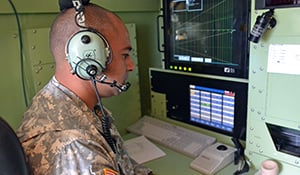
By CSM Eric C. Thom
 While the last decade of deployed operations has stressed our Aviation community, our resilience remains intact. Countless air traffic professionals remain poised to accomplish the next mission, eagerly train and prepare their Soldiers to perform at the highest levels, and continuously seek opportunities to put their technical skills to the test.
While the last decade of deployed operations has stressed our Aviation community, our resilience remains intact. Countless air traffic professionals remain poised to accomplish the next mission, eagerly train and prepare their Soldiers to perform at the highest levels, and continuously seek opportunities to put their technical skills to the test.
Maintaining this pace and excellence as we transition out of deployed operations will require a continued modernization of air traffic systems, and a keen understanding and technical competency of complex air traffic environments. The Branch’s effort to modernize tactical systems has provided air traffic services (ATS) units the capability to support Aviation operations across a broad range of requirements.
Army tactical ATS systems include: the Mobile Tower System (MOTS); the Air Traffic Navigation, Integration, and Coordination System (ATNAVICS); the Tactical Terminal Control System (TTCS); and the Tactical Airspace Integration System (TAIS) all of which are described in more detail elsewhere in this issue.
While equipment modernization is on track, accessibility of live aircraft traffic training opportunities and integration of ATS into home station collective training events can be a challenge. Although ATS units have the required personnel and equipment, they do not own the “traffic” required to support controller training.
Equipment and academic training is only part of the certification process for our controllers. Unit training programs must include live traffic events to ensure Soldiers possess the skills and abilities required to provide safe and expeditious air traffic control in support of Army, Joint and coalitional operations.
Training Strategies
The Aviation Enterprise has developed two deliberate actions to support training opportunities for tactical air traffic controllers. First, Product Manager, Air Traffic Control (PM ATC) has worked diligently to develop and provide simulation capability for ATS units. This effort resulted in the recent fielding of the Air Traffic Control Common Simulator (ACS). Over the past 18 months, this program advanced from a concept on the drawing board to a system being utilized in the field for qualification and currency training. The ACS provides a cost effective and realistic training capability for commanders to incorporate into their training program and can be utilized to meet approximately 50% of position time training requirements.
The second action is to change AR 95-2 to solidify the requirement for tactical units to utilize fixed-base ATC facilities to support certification and proficiency training programs. I know there are those out there that will say no change is necessary because we have always had the option of training in fixed-based facilities, and that is true to a degree. The problem had more to do with interpretation and limitations than the authority to conduct the training.
Some units have achieved great success working with Installation Management Command (IMCOM) facilities to train controllers, while others have struggled with coordination and availability of personnel to take advantage of the training opportunities our installation airfield ATC facilities provide. The change to AR 92-2 is intended to provide commanders a better understanding of how fixed-base training opportunities are essential to their unit air traffic training program.
An extract of the change states:
Army installation ATC facilities (includes Army contract facilities) will be utilized to train Army air traffic controllers assigned to tactical units. These facilities provide essential technical training for certification and proficiency. Installation air traffic density, hours of operation, and internal training requirements will be used to determine the number of military controllers that can be trained in the facility during a given period.
Utilization of installation ATC facilities for Soldier training requires close coordination with IMCOM and continuous oversight from unit leaders. A few points to remember: A letter of agreement (LOA) is required to outline the overall training program, objectives and responsibilities for the tactical unit and IMCOM facility. The unit must be prepared to apportion Soldiers to this training for the agreed time period or until training objectives (i.e., initial qualification, currency, etc.) are met. And finally, unit training NCOs must ensure all training is documented as controller position time completed in a fixed-base facility can be counted toward a rating for a tactical system.
We will continue to modernize our ATS tactical systems, but we must not lose sight of our obligation to provide realistic and demanding training in order to ensure our Soldiers are prepared to conduct operations in complex environments we surely will encounter during future deployment operations. If you take nothing else from this article, remember: if you want them trained and ready when you need them, then you need to be there when they need you.
I am always interested in feedback and ideas that can improve training. If you have a suggestion that you believe could improve or facilitate unit or individual controller training, I would be happy to hear from you. Above the Best!
CSM Thom
This email address is being protected from spambots. You need JavaScript enabled to view it.
CSM Eric C. Thom is the command sergeant major of the Aviation Branch and the U.S. Army Aviation Center of Excellence, Fort Rucker, AL.
caption: SPC Michael Elizondo, an air traffic control specialist from Company F, 2nd General Support Aviation Battalion, 4th Aviation Regiment, 4th Combat Aviation Brigade, 4th Infantry Division, prepares to run simulated aircraft approaches during ATNAVICS radar system training at Butts Army Airfield on Fort Carson, CO.
Credit: U.S. ARMY PHOTO BY SGT JONATHAN C. THIBAULT, 4TH CAB PAO










